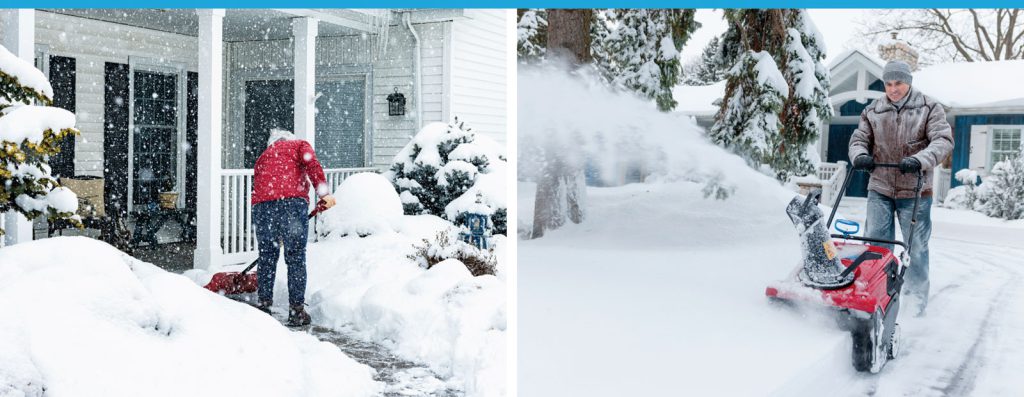Cold temperatures and decreasing daylight hours do not mean that your outdoor running routine has to go into hibernation for the winter. Running through the cold weather can ease the winter doldrums, improve your energy level, and help you to be in better shape for the upcoming seasons. However, it is important to follow these cold-weather exercise tips to run safely and comfortably through wintry weather.
Pay attention to temperature and wind chill. If the temperature drops below zero degrees F, or the wind chill is below -20F, you should hit the treadmill.
Protect your hands and feet. It is estimated that as much as 30% of your body heat escapes through your hands and feet.
Dress in layers. It is important to start with a thin layer of synthetic material, such as polypropylene, which wicks sweat away from your body. Stay away from cotton as a base layer, because it holds moisture and will keep you damp. If it is really cold out, you will need a middle layer, such as polar fleece for added insulation.
Avoid overdressing. You should feel a slight chill off your body the first 5 minutes of winter running; after that, you should warm-up.
Protect your head. Wearing a hat will help prevent heat loss which is very important.
Do not stay in wet clothes. If you get wet from rain, snow or even from sweat in chilly temperatures, you are at risk for hypothermia. It is important that you change out of wet clothing immediately and get to warm shelter as quickly as possible.
Stay hydrated. Despite the cold weather, you will still heat up and loose fluids through sweat. The cool air also has a drying effect, which can increase the risk of dehydration. Make sure you drink water or sports drinks before, during, and after you run.
Remember sunscreen. Sunburn is still possible in the winter. It is also important to protect your lips with lip balm.
Take it easy when it is frigid. The colder the temperature becomes, the greater your risk for a pulled muscle when running in the cold, so warm up slowly and run easily on very cold days.
Run in the wind. If at all possible, head into the wind, so that on your return run, the wind will be at your back when you are sweaty and could catch a chill.

Snow shoveling tips to avoid an injury:
A common cause of soft tissue injuries and low back pain
An average of 11,500 people are treated at emergency rooms for injuries and medical emergencies related to snow shoveling each year, according to a report by the Center for Injury Research and Policy at Nationwide Children’s Hospital. Data shows the majority of the injuries were soft-tissue injuries, with the lower back being affected 34 percent of the time. Acute musculoskeletal exertion was the cause of injury in 54 percent of the cases, followed by slips and falls (20 percent) and being struck by a snow shovel (15 percent). It is recommended individuals talk to their doctor before shoveling snow, particularly those who do not exercise regularly, have a medical condition or are in a high-risk group. They also recommended alternative snow removal methods.
Clearing snow and ice tips
Clearing snow and ice from driveways and sidewalks is hard work. To prevent injuries, follow these safety tips from the National Safety Council, the American Academy of Orthopaedic Surgeons, and other prevention organizations.
- Dress warmly, paying special attention to feet, hands, nose, and ears.
- Avoid shoveling snow if you are out of shape. If you have a history of heart trouble, do not shovel snow unless your doctor says it’s okay.
- Do light warm-up exercises before shoveling and take frequent breaks.
- If possible, push snow in front of you. If you have to lift it, pick up small amounts and lift with your legs, not your back. Do not toss snow over your shoulder or to the side.
Use ergonomic lifting techniques
Whenever possible, push the snow to one side rather than lifting it. When lifting the snow shovel is necessary, make sure to use ergonomic lifting techniques.
- Always face towards the object you intend to lift. (For example, have your shoulders and hips both squarely facing it.)
- Bend at the hips, not the low back, and push the chest out, pointing forward. Then, bend your knees and lift with your leg muscles, keeping your back straight
- Keep your loads light and do not lift an object that is too heavy for you.
- If you must lift a shovel full, grip the shovel with one hand as close to the blade as comfortably possible and the other hand on the handle (handle and arm length will vary the technique).
- Avoid twisting the back to move your object to its new location. Always pivot your whole body to face the new direction.
- Keep the heaviest part of the object close to your body at your center of gravity. Do not extend your arms to throw the snow.
- Walk to the new location to deposit the item rather than reaching or tossing.
WARNING FOR SENIORS:
Whenever possible, avoid shoveling snow first thing in the morning. If this is not an option, a proper indoor warm-up will prepare the body for additional activity. Jogging in place, or using a treadmill or stationary bike for 5-10 minutes are options for safely raising the heart rate while in a neutral temperature. As with any exercise, drinking lots of fluids will help maintain electrolyte balance and prevent fluid loss.
©2023HealthSpot References: (1) Research from Nationwide Children’s at www.nationwidechildrens.org. (2) National Safety Council (3) American Academy of Orthopaedic Surgeons

